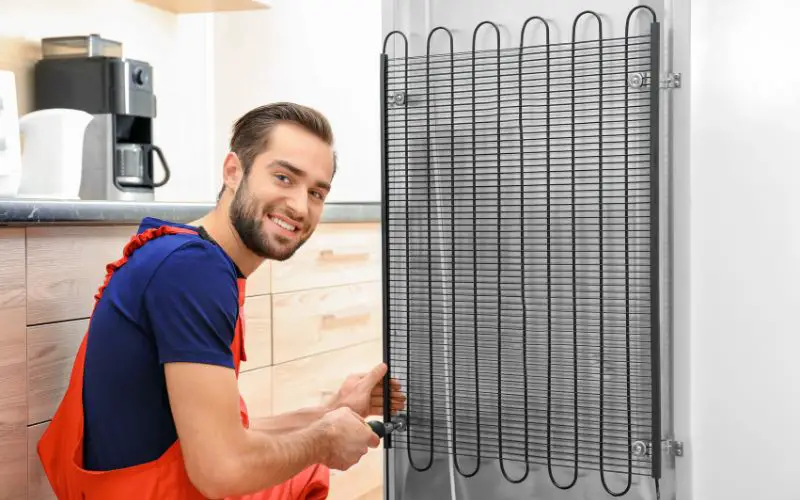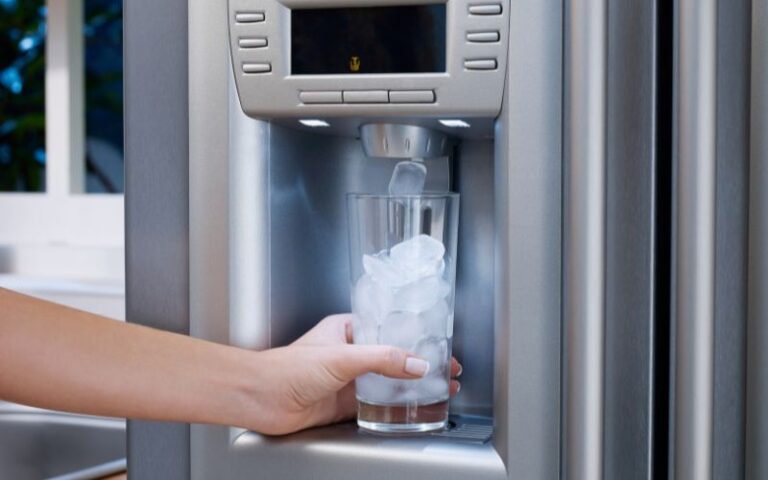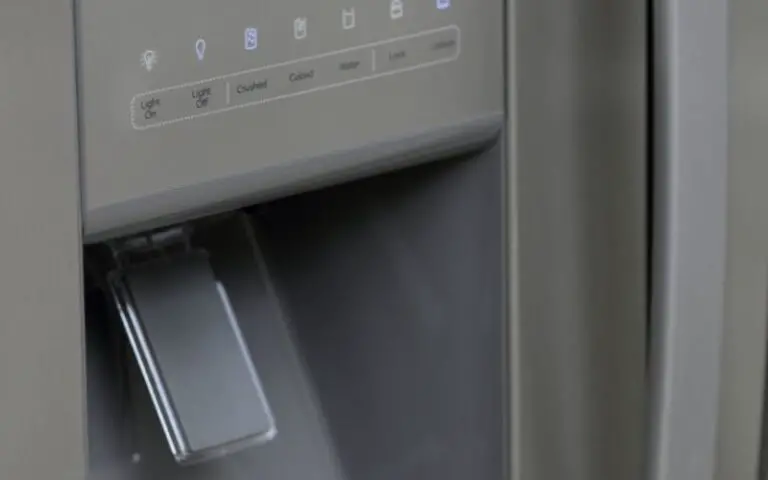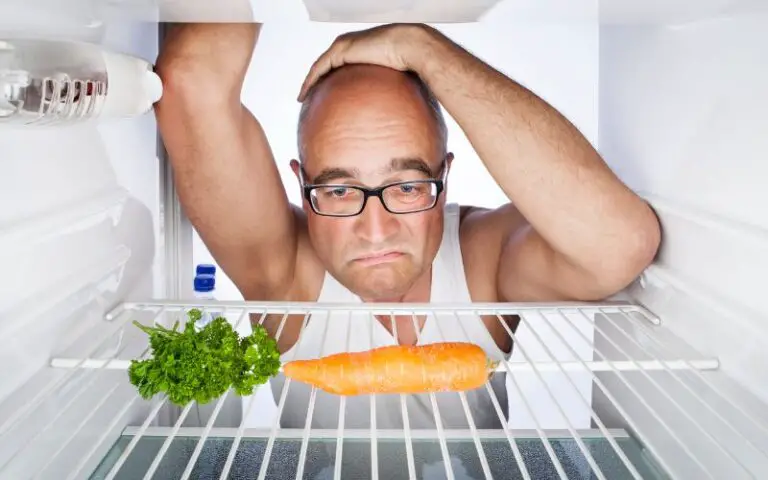7 Reasons Your Refrigerator Evaporator Coil Partially Frosted!
Is your refrigerator evaporator coil partially frosted, and you’re left confused about what the reasons and solution are?
Don’t worry; it’s customary to be worried when this appliance develops faults. Besides, a partially frosted evaporator coil is one of the common problems with refrigerators.
If you notice your evaporator coil is partially frosted, you may want to find out why it happens. Fortunately, I’ll be helping you out with that.
Your refrigerator evaporator coil will partially frost over with continuous usage due to the passage of humid air over them. With time, the moist air condenses and solidifies over the coils. Also, if the defrost heater or thermostat is faulty, it’ll encourage the build-up of ice over the evaporator coils. Additionally, faulty door gaskets will cause frosting on the coils.
This article will help you understand how frost forms on your refrigerator evaporator coils. Also, you’ll get to know when the coils get frozen and the steps you should take to fix them.
Why is My Refrigerator Evaporator Coil Partially Frosted?

Several factors lead to the presence of frost on your refrigerator evaporator coils.
First, due to the mechanism of these indoor coils, frost will form on them as they function to dissipate cold air in your fridge.
During the refrigeration cycle, the indoor coil receives hot air from the condenser coil and removes the heat. Cold air then circulates through the refrigerator to make our food cold.
So, it’s in this cycle that frost forms on the evaporator coil. However, the refrigerator allows regular defrosting to free the coils from ice accumulation.
So, the coils will be partially frosted if the mechanism involved in the defrosting cycle is faulty.
Below are the factors responsible for the partial frosting of the evaporator coils:
#1. Malfunctioned Defrost Heater
A refrigerator defrost heater functions to keep ice build-up from the evaporator coils.
This part regularly rotates to produce heat to melt the frost on the coils when the thermostat indicates a low temperature.
However, if this component becomes faulty, it will need more heat to melt the frost, which it can’t handle. And this will lead to partial frosting of the loops.
#2. Malfunctioned Defrost Thermostat
The defrost thermostat is the part of the refrigerator that observes the evaporator loops for a low temperature.
When the coil’s temperature falls below the dew point temperature, dews develop on the surface. So, once the thermostat detects a serious drop in temperature, it signals the heater to begin work.
However, if this component becomes faulty, it won’t be able to send a signal to the heater, preventing defrosting. Resultantly, frost will build up on the coils.
#3. Damaged Defrost Timers/Circuit Board
Another factor that can create partial frost on the evaporator coils is a damaged defrost timer. This part of the fridge turns on the defrost heater to deal with accumulated frost.
The defrost timer moves into the defrost cycle to carry out this action. However, if the defrost timer is faulty, the heater won’t melt the frost on the loops.
On the other hand, some fridge models have a control board that controls the defrost cycle instead of a timer. Once this part develops cracks or burns, it’ll affect defrosting.
#4. Faulty Door Gaskets
Another reason your fridge evaporator coil will partially frost over is if the door gasket is worn-out.
This component prevents moist air from entering the fridge or leaving by sealing the door completely.
If the door gasket is worn-out, moist air will seep into the refrigerator even when you close your fridge door. Also, humid air will leak into your fridge if you don’t shut the door properly.
Once there’s the continuous entrance of humid air, the coils will frost over quickly after the air condenses.
Consequently, the defrost cycle won’t be able to keep up and handle the accumulated frost.
#5. Too Much Humidity in the Surrounding
If there’s too much humidity in the surrounding, the moist air can rush into your fridge with a slight door opening.
And if this occurrence continues repeatedly, it’ll cause a build-up of ice faster than the defrost cycle can handle.
#6. Dirty Evaporator Coils
Another reason your fridge evaporator loops will partially frost over is if the coils are dirty. Dust and dirt can clothe the loops and prevent proper airflow.
As a result, there won’t be enough heat to melt the ice that accumulates on the coils.
#7. Overloading Your Refrigerator
Another factor that can lead to partial frosting is overloading your fridge with food.
If you overpack your refrigerator, there won’t be space for air circulation. Without proper airflow, frost can quickly form on the coils.
How Do I Know if My Refrigerator Evaporator Coil Is Frozen?
The primary symptom of a frozen refrigerator evaporator coil is a faulty system. First, the fridge will lack enough cold air to preserve your food.
In addition, the fridge’s compressor will take the most hit due to the frozen coil, which may damage the refrigerator severely.
Below is a table showing the signs that point at a frozen evaporator coil:
| Problems | Symptoms |
|---|---|
| Reduced air Circulation | Refrigerator remains warm |
| Faulty thermostat | The fridge is not getting cold and excessive heating |
| Compressor Damage | The compressor produces loud noise, overheats, and turns on and off |
| High energy consumption | Spike in utility bill |
How Much Should Frost Be on a Refrigerator Evaporator Coils?
With constant usage, there should be very little to no frost on your refrigerator’s indoor coils. However, many refrigerator users conclude that frost on the evaporator coil is not a problem.
As I have earlier established, frost formation on evaporator coils occurs regularly as long as you use your refrigerator.
But, it becomes a problem when this thin ice builds up on the loops. So, while frosting occurs, you should know that partial frost on the coils indicates malfunctioning.
From a faulty defrost heater, thermostat, and timer to a torn door gasket, all these issues lead to frost formation on the loops.
So, you should always watch out for the signs of too much frost on the coils and ensure you act swiftly.
Furthermore, slight frost on the coils may not harm your fridge; you only need to ensure it doesn’t accumulate over time.
How Do I Fix Partially Frosted Refrigerator Evaporator Coils?
There are different methods to fix partially frosted evaporator coils. The immediate solution is to defrost the thermostat and the heater.
However, if these parts are faulty, you’ll have to repair or replace them. Also, regular fridge maintenance is essential, which involves cleaning the coils. Cleaning the coils will keep dirt from clogging, which can prevent frosting.
Below are the steps to fixing partially frosted evaporator coils:
#1. Defrosting the Thermostat
To defrost your thermostat, follow this process:
- Adjust the thermostat to the desired temperature for the freezer and fridge.
- Place a container to collect the running water from the exit pipe behind the fridge.
- Once the fridge reaches the set temperature, the compressor will go off. This action will melt the frost.
- You can then empty the container once it fills up.
#2. Manual Defrosting
These days, refrigerators don’t need manual defrosting because they come with an automatic defrost system.
However, older models may need manual defrosting for ice build-up. To carry out manual defrosting, follow these steps:
- First, remove all contents from the fridge and freezer.
- Then, place a dry cloth under the refrigerator’s door to soak up running water.
- Adjust the thermostat to zero and disconnect your refrigerator from the power supply.
- Open your fridge’s door to allow air to flow in.
- Next, dry the compartments and evaporator coil with a clean towel
- Reconnect the fridge to a power source, then set the thermostat
#3. Defrosting the Heater
Another process involves defrosting the heater. To defrost the heater, do the following:
- First, remove every content from the fridge, including the trays and baskets.
- Next, adjust the thermostat to zero.
- Turn on the defrost heater to allow warm air to circulate.
- Also, use a connecting pipe to push air into the evaporator coils.
- Leave the refrigerator’s door open.
- At the bottom of the fridge, you’ll find a water tray you should empty.
#4. Check the Defrost Heater and Thermostat
After defrosting the necessary compartments and the problem repeats immediately, you should check for defective parts.
Use a multimeter to test for continuity in the defrost heater and thermostat. If there’s no continuity, you should replace the heater and thermostat.
#5. Check the Defrost Timer
To check if the defrost timer is functioning correctly, slowly move the knob into the defrost cycle. When you move it, the compressor should turn off, and the heater will come on.
If the timer doesn’t set off the compressor or turn on the heater, it’s damaged.
Also, if the dial remains in the defrost cycle after 30 minutes, it isn’t functioning. It would help if you replaced the defrost heater.
#6. Inspect the Door Gasket
You should also check the door gasket for weakness or dirt. If there’s dirt on the gasket, it can prevent it from sealing the door completely. You should clean every dirt thoroughly.
Also, to check if the gasket is functioning correctly, carry out a paper test:
- Close the fridge’s door on a thin paper or dollar bill.
- Gently try to pull it off. If it comes out quickly, then it indicates a faulty gasket. It would help if you replaced it immediately.
Final Words
Conclusively, your refrigerator evaporator coils will become partially frosted for the following reasons:
- Malfunctioned Defrost Heater
- Damaged Defrost Timers/Circuit Board
- Faulty Door Gaskets
- Too Much Humidity in the Surrounding
- Dirty Evaporator Coils
- Overloading Your Refrigerator
All these results when there’s not enough air circulating in the loops. This lack of air can result from a faulty defrost heater, thermostat, or timer.
Resultantly, it leads to your fridge not cooling appropriately and compressor damage. So, defrost the thermostat and heater, and replace damaged parts to fix a frozen coil.
References:







